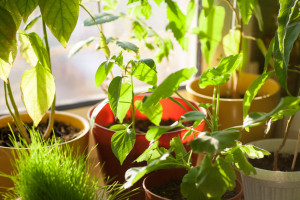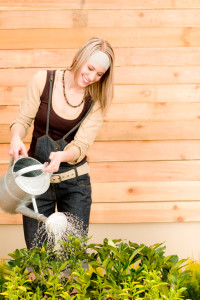Container Gardening: What You Need to Know
Indoor gardening can involve anything from elaborate growing walls to a few simple plants. In southwestern Ontario, bringing the outdoors inside can allow you to extend the growing season. While the outdoors are covered in snow, you can enjoy beautiful flowers, herbs, vegetables, and other plants in your home. Even if you have a postage-stamp-sized garden, potted plants give you the option of trying your hand at gardening.

GETTING STARTED

Ecology concept. Potted green plants on window sill indoors
One of the advantages of indoor gardening is that you don’t need much to get started. You will need:
- Containers. You can buy decorative containers or simple terracotta pots. You can even create your own containers out of just about anything, from galvanized metal tubs to barrels cut in half – as long as the container has drainage holes at the bottom.
- Plants. Just about any plant that can grow outside can thrive in a container indoors, as long as you offer it the conditions it needs. You can grow herbs and vegetables if you want fresh food or flowers if you want some colour added to your décor. If air quality is a concern, bring Aloe Vera, spider plants, or Gerber daisies into your home.
- Potting mix. Look for a porous soil that is intended specifically for potting. This will not trap moisture in the container so that roots can thrive.
- Fertilizer. Potted plants can’t get nutrients as easily, so they need fertilizer. Look for an organic blend designed specifically for container gardening and fertilize often. Plant food that can be mixed with water is especially good for potted plants, since it can replace the nutrients that get eliminated with frequent watering.
KEEPING YOUR GARDEN HEALTHY

- Find out a little about the plants. Read up about the plants you have selected for your home. Do they need lots of sunshine or partial shade? do they like a lot of water? Plants have different needs, and knowing where to place your garden correctly how to create a watering and feeding schedule is crucial.
- Provide water. Indoor plants cannot rely on rain and many indoor environments are quite dry, which means you need to water often. Keep the soil moist but not soggy. When you see that the top layer of soil is starting to feel dry, water the plants, stopping when you see water seep out through the drainage holes. If the plants develop dry spots, you may be under-watering.
- Feed the plants. Use fertilizer to add nutrients to the soil. Read the labels on your potting soil. If the soil comes with short-term fertilizer, add plant food every two weeks to start, adjusting if you notice that the plants are not thriving.
- Rotate your plants. When roots sprout out the bottom of the pot or near the top of the soil, it’s time to upgrade to a larger container to give the plant some additional room.
No matter what your garden size, you can create a beautiful green area. For help with your landscaping needs, call us at Cedargate Landscaping for a consultation about your project.
Latest posts by Team Cedargate (see all)
- WHY TRUST IS SO IMPORTANT TO US - December 15, 2019
- MORE ON LANDSCAPE LIGHTING - February 16, 2019
- 5 Ways Landscaping Can Increase Your Home Value - January 5, 2019
